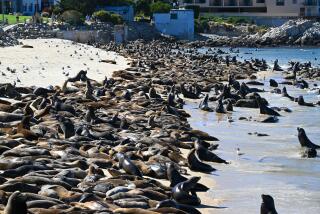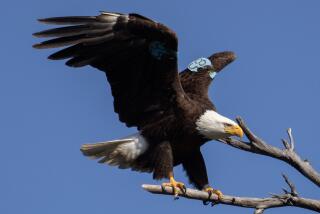A Tern for the Better : Two Man-Made Islands at Bolsa Chica Reserve Lure Flocks of Birds
- Share via
When wildlife experts built two sand islands in the tidal backwaters of the Bolsa Chica Ecological Reserve 15 years ago, they sought to create a nesting area for the California least tern.
“It worked like a dream,” said Charles Collins, a Cal State Long Beach biology professor who studies birds at the preserve. “They very soon colonized it. For a number of years, they bred on both islands.”
In recent years, the least terns have had company on the islands and the nesting areas have worked even better than most wildlife experts envisioned.
Other types of terns have been coming to North Island and South Island in increasing numbers to breed and make shallow nests in the sand that rises just above the salt marsh’s placid waters.
Now, during summer months, Caspian terns, elegant terns, Forster’s terns and black skimmers (another type of tern) can be seen flocking together a short distance from the main entrance to the 530-acre preserve on Pacific Coast Highway near Huntington Beach.
As the other terns have moved in, they’ve taken over North Island, limiting the smaller least tern to South Island. So far, Collins said, a balance is being maintained.
“Some worry that if numbers (of other terns) start to build and they move over to South Island, they could squeeze out the least tern,” Collins said. “But as long as they are on separate islands, there doesn’t seem to be much problem.”
Caspians, a more aggressive tern, first started breeding in the preserve in 1986. Possibly because they provide somewhat of an “aerial defense force” against predators, the Caspians were joined within a year by the other terns, Collins said.
Of all those varieties, Collins has been most interested in the elegant tern.
Although the elegant tern can be found with other terns along the West Coast, it previously had only two known active breeding colonies--in Mexico’s Gulf of California and in San Diego Bay.
In 1987, about 31 breeding pairs of elegant terns were observed at Bolsa Chica, Collins said. Those numbers have increased almost every year since. He estimated about 1,800 breeding pairs nested on the island this year.
Collins theorizes that the influx of elegant terns is the result of the bird expanding its northern range as its primary food source, the Northern anchovy, has become more abundant in coastal waters here.
In possible support of his theory, Collins said that when the local population of anchovies, which thrive in cooler water, dropped last year due to ocean warming from an El Nino condition, the number of elegant terns plummeted, too. Instead of the 1,200 breeding pairs counted at Bolsa Chica in 1991, Collins said only about 150 were recorded in 1992.
This year, with ocean temperatures lower, the number of breeding pairs returned to higher levels.
The elegant terns already have left Bolsa Chica this year. They begin arriving about June and departed for their winter grounds in Central America and South America about mid-August. During their time at the reserve, they could be seen in aerial courtship rituals and carrying fish from the ocean to their nests, he said.
The other terns remain in the area or fly to other grounds along the California coast, Collins said.
Another reason for the growing numbers of terns is that each year members of Amigos de Bolsa Chica, an environmental group working to protect and restore the wetlands, leads an effort to remove vegetation that would otherwise cover up sand on the islands.
“We do a little cleanup and gardening for nature,” said Terry Dolton, the group’s president.
Dolton called the islands “maybe over-successful” in attracting the birds.
“We just don’t want to see it get to the point where the least terns are muscled out,” he said. “In the long term, we would like to see other nesting island opportunities included in the restoration plans.”
More to Read
Sign up for Essential California
The most important California stories and recommendations in your inbox every morning.
You may occasionally receive promotional content from the Los Angeles Times.













